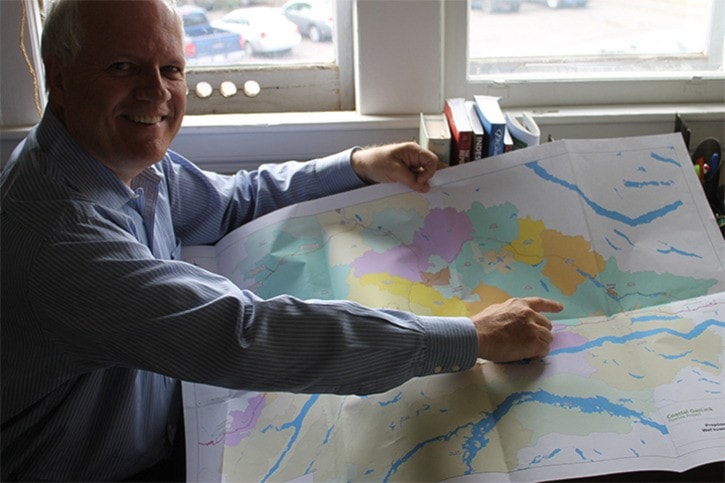President of TransCanada’s Coastal GasLink, Rick Gateman, provided Lakes District News with an update on their liquefied natural gas (LNG) pipeline project.
TransCanada has been selected by Shell Canada Limited and its joint venture partners in the LNG Canada project to develop an approximately 650-kilometre pipeline to deliver natural gas from the Montney gas-producing region, near Dawson Creek, B.C., to LNG Canada’s proposed liquefied natural gas facility near Kitimat, B.C.
It is estimated that around half of the natural gas extracted, around five billion cubic feet a day, would run west along the pipe line and then be shipped by tanker to Asia once the project is complete.
The pipeline is planned to be around 670 km long, and 48 inches in diameter and will be submerged underground for most of the route.
In terms of how the project will impact the Lakes District, Gateman conceded “there will be times when you will hate us,” count on there being many large trucks and dust and noise. However, Gateman pledges that the company has and will continue to try to mitigate these effects through job creation, community investment and consultation.
Gateman explained that as of now, Coastal GasLink is in the process of finalizing permits, agreements and cost estimates for submission to the LNG Joint Ventures Partnership by the end of September 2015. The final report will go before LNG in October and Gateman expects their decision to finalize the project take a couple months, as some of the companies are state owned, he expects a decision next year.
Gateman clarified that this process was risk assessment by LNG, in order to make sure everything is feasible and that there is no widespread opposition from local communities and First Nations. As of now, Coastal GasLink has received environmental approval, and has met nearly all of the requirements for the Oil and Gas Commission and expects to do so by September.
As part of the environmental assessment process, Coastal GasLink consulted with First Nations bands whose territories run along the right of way of the pipeline. Consultation often led to interim agreements; out of roughly 21 bands that Coastal GasLink has consulted with 20 have signed such agreements. The next goal for the company is to sign long-term project agreements; so far Coastal GasLink has signed six bands out of 21. “There is no real legal requirement to have agreements done, but we’re trying to get as many done as we can,” he said.
Opposition does exist however, and Gateman is worried it may come to a head soon. Gateman refers to the Unist’ot’en camp that was set up six years ago on the Morice River Bridge in Wet’suwet’en territory, which was originally created in opposition to the Enbridge pipeline project but has now extended to protest all proposed pipelines in the area.
Gateman explained that the company has documented 92 different attempts at communication with one specific house, one of twelve houses of the Wet’suwet’en hereditary chief system.
“The leader of the dark house and their spokesperson has refused to deal with us,” he said - the leader of dark house being Chief Knedebeas (Warner Williams), and the spokesperson Freda Huson.
Gateman describes how Coastal GasLink field workers have been blocked from conducting their work by protestors in the spring of this year. He was also surprised to see protestors in the camp from different parts of Canada and the U.S.
“We can see the license plates on their vehicles and they are aligned as environmental activists who have come up to this camp,” he said.
In response to the protest Coastal GasLink has made an amendment to the original plan for the pipeline, moving the pipeline north by five km in order to avoid the camp, and to address some of the concerns that the protestors had including the concern that the original pipeline route would interfere with a number of springs that fed into the Morice river.
Additional fieldwork and assessments in the area will have to be done for the amended route as early as this week and Gateman says, “We are expecting some reaction.”
“We have to notify the RCMP of what we are doing and they’ll have to do their own response if we’re blockaded.”
Gateman contends that many of the protestors in dark house territory are against all hydrocarbon development, and he thinks that involving the RCMP may be inevitable.
“So that’s probably coming cause we need to get in there and do this late season work and we need to be in dark house”
